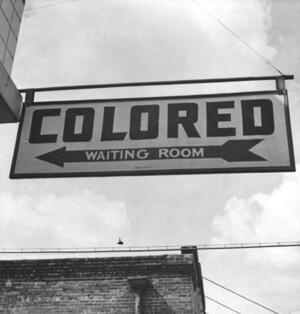Moments of Personal Resistance
Examine how individuals take stands against racism and injustice using an essay by Grace Paley and three other short vignettes of individual protest.
Overview
Enduring Understandings
- Individual acts, including our own, are powerful tools in effecting change.
- There are many ordinary people and "unsung heroes" who should be considered Jewish role models.
Essential Questions
- What motivates people to resist as individuals?
- What values, experiences, and actions could motivate me to personal resistance?
Materials Required
- "Signs of Segregation"
- Computer, projector, and screen/blank wall (or print-outs of the Signs of Segregation slide show images)
- Copies of Document Studies
- Handouts
Notes to Teacher
The Moments of Personal Resistance lesson includes three sections, plus an optional fourth section. There are several ways that the fourth section can be used including:
- Use as part of the regular lesson if you have a longer teaching block (approximately 2 hours for the whole lesson).
- Use as part of the lesson when using this lesson as a special event.
- Since the fourth section deals specifically with the literary genres of satire, if you are in a school where secular and Jewish subjects are taught, your students' English teacher could teach section four to coordinate with your teaching of this history lesson.
Another option for an additional assignment or class activity is to interview someone who has a story of personal resistance. This can be done in class, by bringing in a speaker and interviewing him/her in front of the class, or as an outside assignment, in which students choose someone to interview themselves. See JWA's "How-To" section for a downloadable oral history guide and a set of "Twenty Questions" for interviewing American Jewish women.
This lesson is about individuals who stand up to injustice instead of remaining passive bystanders. If you and/or your students have worked with the organization Facing History and Ourselves and are familiar with the term "upstander," consider using the term throughout this lesson plan. Facing History defines upstanders as, "people who choose to take positive action in the face of injustice in society or in situations where individuals need assistance." When witness to a bad situation, upstanders actively respond while bystanders just stand by. (Facing History defines bystanders as “individuals or groups who do not help person(s) in need.”)
Vertical Seating at a Lunch Counter
Open this section in a new tab to print
Eli Evans grew up in Durham, NC, where his father owned Evans United, a dry goods store that served whites and blacks alike. One of the services provided by the store was a lunch counter where shoppers could get a bite to eat. In The Provincials, Evans tells the following story.
Ours was a poor people’s store and we catered to the Negro trade. In the strange contorted world of what passed for Southern liberalism just after the war, Evans United was the first store on Main Street to have restrooms for blacks; we were the only Main Street store with an integrated lunch counter, though it hadn’t been easy. When Bus Borland, the county judge, sent word that North Carolina law prohibited feeding blacks and whites together unless a wall separated them, my father told him, “Bus, you’ll have to close the store if you want me to do that.” Gene Brooks, our lawyer, called a meeting at the courthouse to point out, after exhaustive research, that the legal precedents all involved seated counters, and Bus agreed that it was so, not wanting to make a whole lot of trouble. So my father agreed to remove all the stools at the counter and instructed the carpenters to raise the counter top to elbow-leaning height so that United could proudly retain the only integrated lunch counter in downtown Durham.
Eli N. Evans, The Provincials: A Personal History of Jews in the South (New York: Simon & Schuster, 1997. Reprinted University of North Carolina Press, 2005), 27.
I Have Taken Stands - excerpt from Bernice Stern oral history
Open this section in a new tab to print
During World War II, there were a lot of black servicemen who were at the U.S. Naval Hospital where we worked every week. And they’d play music and there were no black girls with whom they would dance. So I would dance with the boys that didn’t have anybody to dance with and so would some of the other women who were with me. And so at the next meeting of the Gray Ladies the head stood up and said, “We do not wish you to dance with the fellows, with the servicemen.” I stood up. I said, “Are you going to have young black girls to dance with the servicemen? No! Well, then we will continue to dance with them. I object strenuously to your using these boys to fight our battle with us and for us but not have girls for them to dance with.” And the head of the Gray Ladies said, “We are not going to permit that.” I said, “Well, then I am resigning as a Gray Lady.” A few others did but not many. I have taken stands on organizations like that.
Bernice Stern, oral history conducted by Pamela Brown Lavitt for the Jewish Women's Archive on 22 June 2001.
"The Provincials"
Eli N. Evans. The Provincials. (New York: Free Press Paperbacks, 1997.)
"Only in America"
Golden, Harry. Only in America. Cleveland: The World Publishing Company, 1958.
Grace Paley "Jewish Women: A Comprehensive Historical Encyclopedia"
Grace Paley entry in Jewish Women: A Comprehensive Historical Encyclopedia: jwa.org/encyclopedia/article/paley-grace
"Just as I Thought"
Grace Paley, Just as I Thought. New York: Farrar, Straus and Giroux, 1999.



